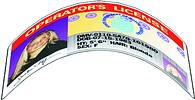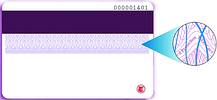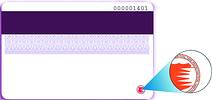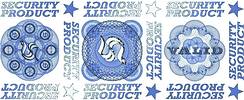
High-tech printing makes ID cards more secure. From serialisation to micro details to improved durability, cards are tough to copy – and just plain tough!
Security is on everyone's minds these days. Is that driver's licence or ID card an authentic document? Does it have all the security features you have been told to look out for? Does the photo match the person? Does the signature on the sales slip match the one on the card?
In most lines of work, secure identification starts with a photo identification card. Key features are a good photo likeness and a legible signature. Years ago, those features alone were thought to be sufficient, but not today. Issuing authorities now incorporate in photo ID cards a host of additional features to deter counterfeiting, at the same time making authentication easier and more reliable.
The total card protection formula for optimum security
Security comes from a combination of media features, printer capability, database verification and special security - unusual, covert and forensic features.
Media features include surface quality, durability and built-in security elements. Printer capability encompasses high-resolution graphics and reliable bar codes plus covert features printed at the time of issue. Database verification consists of a central archive of cardholder data, including a photo, personal statistics, employee number, date, time and place of issue. Special security features are only shared with customers, in order to protect their covert qualities.

Start with strong cards
First and most important, the card itself has to be tough. Gone are the days when ID cards could be printed on garden variety PVC stock with a photo that merely resembled the cardholder. In this security-conscious age, government and other large organisations insist on custom-designed card media of ever increasing sophistication. This is for two main reasons. First, multiple security features create greater counterfeiting difficulties. Second, guards can quickly and easily validate unique features, known only to the organisation's security force.
Your card media should offer an array of security features, any or all of which may be incorporated into custom designs. Today's cards must be extremely durable. For example, your card stock should be 10 times (10x) the flex life of regular PVC cards Figures 2, 2a, 3. It should meet or exceed all international standards for resistance to cracking, permanent adhesion of over-laminate, and durability of image.



The lanyard slot in a regular PVC card is often fragile. If it tears out, an unauthorised user needs only to change the photo to go past a careless inspector. Therefore, choose cards that do not tear easily. Look for unique tear-resistant designs.
To increase durability, higher capability printers feature fully integrated hot roll laminating stations that apply 0,6 or 1,0 mil laminate patch materials, with or without holograms. Cards with laminates will provide up to seven years of wear. Such lamination is especially recommended for abrasion intensive applications such as frequent bar code or magnetic stripe reading. Depending on volume and how quickly one needs to print cards, there are printers that laminate one side at a time or both sides at once.
Modern print features are hard to copy
To prevent counterfeiting, alteration or duplication, there are many techniques that companies can employ with digital printers. First of all, they can deploy multiple security images or holograms. One security image alone increases the difficulty of counterfeiting; two makes it at least twice as hard. The holographic image lamination process also provides a very rich-looking card. Multiple screenings of the same photograph increase integrity. This is almost the norm on driver's licences. Unique graphic identifiers, such as allowing only the red-bordered cardholders to access an area, help differentiate security levels.
You can also purchase card stock with pre-printed security features, including ultraviolet-visible text and graphics that are available in two colours, green and blue. With micro-printing (Figure 4) text can be added to a user's specifications, with deliberate random font changes and misspellings if desired. Character height is 5 thousandths of an inch (0,125 mm). Pre-printed serial numbers can also be incorporated into card stock (Figure 5). Laser etching is another option.


Fine-line Guilloche patterns with hidden micro-text are aimed at foiling counterfeiters (Figure 5), and micro-printing of text and miniature graphic elements are also difficult to duplicate (Figure 6). An over-laminate film adds security to the printed ID card. The inner surface of the laminate can be pre-printed with OVI ink (Figure 8) or UV-visible ink in one, two or three colours (Figure 9). And last, but not least, today's high-tech printers can also laminate with holographic metallisation, including embossed micro-text (Figure 10).





Applications for such security-enhanced cards include drivers licences; national health, social security and voter registration programmes; badging for the armed forces, law enforcement and government agency personnel; and access and identification for educational institutions, industry and transportation.
Keeping track of critical information
It is important to keep track of card transactions in the printer's host computer. For example, Zebra's ID/Log records the applicant's personal data, together with other point-of-issue data (Figure 11). This data set can provide a means for security officers to validate the card by comparing a photo ID card with this centrally located data.

Card serialisation adds security. Printers with the magnetic stripe encoder, proximity encoder and smartcard contact options can be set up to function only with serial numbered card stock, and also to add serial numbers to the data recorded by ID/Log.
Here is how card serialisation works. All cards supplied to an organisation using this system are pre-printed on the front or back with a serial number, which is also recorded on the card's credential medium, such as magnetic stripe, proximity chip or smartcard IC. The ID card printer is configured to accept only serial numbered cards and will eject, without printing, any card without the appropriate encoding. If a valid serial number is detected, the card is printed in the usual way.
The serial number read from the credential medium is recorded in the printer's host computer, where it is linked with the licence or employee number and other data such as date, time, and location. This data set is available for uploading at any time to the organisation's central database.
As a result, the security officer can read, on-the-spot, an ID card that is linked in the database to a serial number without any special equipment. When transmitted to the central database, the serial number can, in turn, trigger a download to a local terminal. Now, in addition to the usual comparison of photo and subject, it is easy to check, instantly, the correlation of serial number and credentials.
Security provides peace of mind
By utilising the latest printing technology, your organisation can rest assured it is doing everything it can to prevent identity fraud and to verify that a cardholder is who they say they are. If you are not using the best card printing technology available, you cannot be sure that your cards are secure. And, that is just not acceptable in today's world.

© Technews Publishing (Pty) Ltd. | All Rights Reserved.